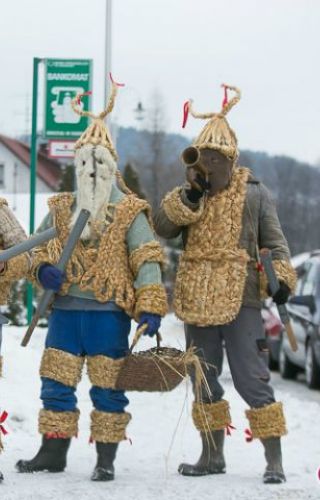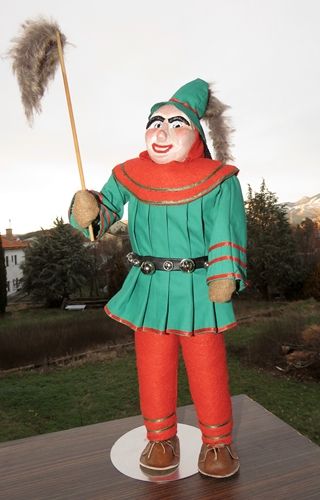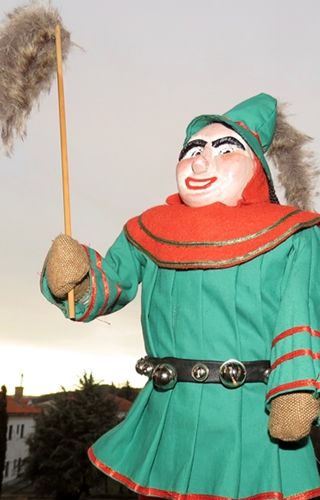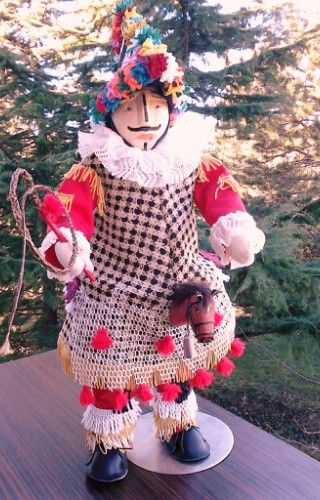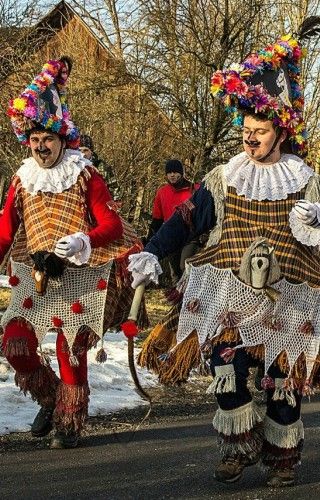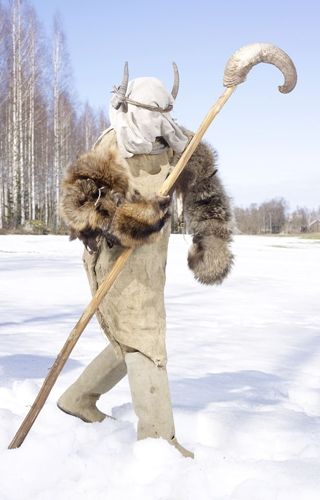BOGIES (Kent)
In the 16th and 17th centuries in England, people would make garlands of flowers and leaves for the May Day celebration. After becoming a source of competition between Works Guilds, these garlands became increasingly elaborate, to the extent that it covered the entire man. This became known as Jack in the Green. By the turn of the 20th century the custom had started to wane as a result of the Victorian disapproval of bawdy and anarchic behaviour. The Lord and Lady of the May, with their practical jokes, were replaced by a pretty May Queen, while the noisy, drunken Jack in the Green vanished altogether from the parades. Jack in the Green was revived in Whitstable, Kent in 1976 and continues to lead an annual procession of Morris dancers through the town on the May Bank Holiday. Rochester, also in Kent, revived the May Day Jack tradition in 1980, as the Rochester Sweeps Festival with an associated awakening of Jack-in-the-Green ceremony held on Blue Bell Hill at sunrise. Another revival occurred in Hastings in 1983 and has become a major event in Hastings Old Town calendar. Ilfracombe in North Devon has had a Jack in the Green procession and celebration since 2000. It is supported by local schoolchildren, dancing around the May Pole on the sea front, and by local morris men and dance groups from in and around the district. Jack is a colourful figure, almost 3m (nine feet) tall, covered in greenery and flowers. In Whitstable, he is accompanied by two attendants, representing the legendary figures of Robin Hood and Maid Marian. In Hastings, he is also accompanied by attendants, here known as Bogies, who are completely disguised in green rags, vegetation, and face paint.
The attendants play music, dance and sing as they guide Jack through the streets to celebrate the coming of Summer.
BURRYMAN (Queensferry)
The Burryman or Burry Man is the central figure in the annual procession which takes place on the second Friday in August in South Queensferry, north of Edinburgh in Scotland. The significance and origins of this ceremony so far are unknown. Burrs are flakes, sticky flower heads of different types of weed. Burry Man is a local man almost completely covered with sticky burrs. Only shoes, hands, eyes and mouth openings were discovered. So he has to walk awkwardly, with wide legs and hands stretched side by side, over nine o'clock to move about seven miles through South Queensferry. He has two assistants who help him all day. They use two flower-covered staves (poles) to support his arms so that they will not stick to his body. They visit city pubs and other locations, and on each of them Burryman drinks whisky, but because of the sticky face he can only drink through the slag. He is not allowed to speak.
By the end of the day he was exhausted.
BUŠAR (Mohač)
The Busójárás (Hungarian, meaning "Busó-walking ) is an annual celebration of the Šokci (Croats) living in the town of Mohacs, Hubgary, held at the end of the Carnivalseason ("Farsang"), ending the day before Ash Wednesday. These traditional festivities have been inscribed on the Representative List of the intangible Cultural Heritage of Humanity of the UNESCO in 2009. According to the most popular legend, during the Ottoman times of the territory, people from Mohacs fled the town, and started living in the nearby swamps and woods to avoid Ottoman (Turkish) troops. The busho clothing is made up of a pair of moccasin or boots, white linen trousers and a mask made of wood. Trousers are always stuffed by straw; the sheepskin is usually turned inside out and gathered round the waist by a rope or a chain with one or several cattle bells on it. Bushos usually have a haversack on their shoulders. Other accessories of the clothing are flappers, war hammer, and a long wooden cornet. Bushos can be usually seen carrying a washtub with a wooden puppet in it.
Among accessories, you can also find the presser ( or pračak), and the water carrier, made of wood (obramenica), formerly gifts, given by lovers.
CERTI (Nedašov)
In the Moravska part of Czech Republic, Saint Nicolas visits residents on the evening of December 5. He is accompanied by the Angel, some Devils and everywhere in Wallachia, by Deth and the Jumper. The figure of the Devil can be very diferent from one to another place. In general, he is dressed in dark fur with a long tongue protruding from the mouth of his mask. He has a large number of bells,chains and he hold a fork. The Devil scares children because he has a bag designed to „carry away the naughry people to hell“. The Jumper is a character in a white costume decorated with coloured ribbons and bells. With the help of a leather whip, he clears the way for the group and announces the coming of Saint Nicolas.
Death, an entirely white figure, uses a scythe to „catch the sinners“
DUNKELFOLKETS (Jutland)
Dunkelfolket is an experienced masked theater group, specializing in parades and street theater. Dunkelfolkets carry unique wooden masks designed and manufactured by local artists, Kirsten Gitz-Johansen. Masks depict different sides of human nature, and as performers direct interaction with viewers. Many shocking, frightening, ridiculous and scandalous situations occur in the streets. Dunkelfolket originates from the beautiful nature of Fosdalen in the northern part of Jutland. Every spring, Dunkelfolket from the mother of nature spreads the concepts of joy, life and death to ordinary people. Since 1989, Dunkelfolket has performed throughout the North Jutland region of Denmark, as well as European and international carnivals, festivals and other organized events. Theatrical masks are almost extinct in the North, but are successful in the rest of the world. In 1989, Dunkelfolkets accepted this ancient tradition and carried it to Denmark. The performances are based on mysticism as a common ground for improvised works. The rigid body mask transforms performers into human sculptures that absorb viewers in the current process of horror and laughter.
The repertoire is inspired by the Nordic and Celtic tradition with choreography produced by internal and external instructors
DZIADY śmigustne (Dobra)
Remnants of old-Slavic pagan traditions, included in celebrations of Śmigus-Dyngus on the Easter Monday in Dobra, Limanowa County, southern Poland. This tradition is connected directly to the custom of Śmigus-Dyngus (also called Lany Poniedziałek - Wet Monday), celebrated on that day throughout Poland. In this local variety, it’s still accompanied by processions of the so-called ’dziady śmigustne’ - the symbolic representations of ancestors arriving for the early spring rites. During these rites symbolic acts of purification after the wintertime and evoking of fertility for the arrival of spring is performed by throwing water on people from the community. The symbolic ancestors (dziady) are wearing costumes made of woven straw and masks of sheep skin (sometimes of cloth). They can’t reveal their real identity or talk, and only murmur, whistle and hoot. They usually carry small baskets, into which they get small offerings such as food, or are greeted with a sip of vodka. They perform ritual dances and pull small pranks by each house they stop by. The most important part includes pouring of water on people and leaving straw for example under their clothes (self-collected straw was seen as a protective magical barrier in the old-Slavic rites). In the modern days, they also go on the streets to stop cars of the locals to get the symbolic gifts, pour water on the car and leave the straw under the windscreen wipers.
Local tales and legends from the Limanowa County are tracing this custom as far back as 13th century, when majority of the community disappeared during the invasion of the Mongolian Golden Horde.
GILLIEIS (Binche)
Around 1000 Gilles, all male, some as young as three years old, wear the traditional costume of the Gille on Shrove Tuesday. The outfit features a linen suit with red, yellow, and black heraldic designs (the colours of the Belgian flag), trimmed with large white-lace cuffs and collars. The suit is stuffed with straw, giving the Gille a hunched back. They also wear wooden clogs and have bells attached to their belts. In the morning, they wear a mask of a particular design. After reaching the town hall, they remove these masks — they are not worn in the afternoon. During the afternoon parade, they throw blood oranges to (and sometimes at) the crowd, and some of the Gilles wear large, white, feathered hats. They carry ramons, tied bunches of twigs, and baskets in which to carry the oranges.
Their sticks are said to ward off evil spirits.
HUDELMALE NARREN (Kisslegg)
Hudelmale is the dominant and oldest guild figure in Kisslegg Carnival. It emerged 300 years ago wearing a sharply cut-out mask with a maliciously witty face and a green hat, adorned with bells and a muhar. In his hand holds a hazelnut stick with three pinks of beads. The dress consists of heavy dark green velvet jackets and pants in red. Belongs to the waist carry a belt with different ring sizes. For Hudelmale also include black or brown gloves and brown boots. Kleinhudler is a baby's mask and has been slightly modified. Children do not wear a mask Hudelmale is just one of the numerous "Narren" groups in Germany and represents only one of their versions on the carnival
KOBYLA (Pardubicky Region)
In the village of Vortová, as well as in several other villages around Hlinsko in the Czech Republic, the old folk carnival tradition of visiting nearby villages has been preserved to this day. The group is divided into the "red" and "black" part. The red masks consist of two red and two blue "turks", "laufr" (also called "colorful"), and the "husband" and "wife". All masks are worn only by men, even the mask called "woman". Each mask has a specific role and place in the parade section: "Kobilas" always lead the parade. Behind them goes the husband with his wife, then "Turks," followed by "Chimney sweepers", "Straws" and "Jews", all accompanied by a brass band. After the approval of the mayor, a masked parade goes on a tour of all the houses in the village and in each requests permission to visit. The masks of the Turks are worn by unmarried young men and their job is to dazzle the audience with their dance. In addition to cleaning the chimneys, the chimney sweepers also blacken everyone with soot for good luck. The straw, according to mythology brings health and fertility, while the Jews are in charge of trading needed or more often unnecessary things as well as offering various services, such as shaving. Throughout the day, the parade is accompanied by upbeat music from the brass band until the very end when the Kobila is ritually killed. The Kobila represents all the bad things that have happened over the past year. After that, everyone in the parade removes their mask and forms a circle around the Kobila while the music performs a funeral song.
Then the party continues long into the night.
Маланка ведмідь ( Malanka Bear)
In the small Ukrainian town of Krasnoilsk, just a few miles north of the Romanian border, everyone is pitching in to make painstaking, yet festive, preparations. Malanka is a Russian, Ukrainian, and Belarusian folk holiday celebrating the New Year on January 13th, in accordance with the Julian calendar. The story of Malanka is based on the creator Praboh, who had four sons and a daughter. One son was the devil, the second was St. George, the third was St. John, and the fourth was Lad or Myr (Peace). His daughter was Lada, Mother Earth, who herself had a son called the Moon, and a daughter called Spring-May, also known as Mylanka.
The Devil kidnapped Mylanka one day, while her brother, the Moon, was hunting, and brought her to his underground world. As Mylanka was responsible for blooming flowers and the greenery of spring, the world was left without spring. When she was released, spring returned, and Malanka was created to symbolize the release of spring. Ukrainian rural areas celebrate Malanka with well-attended festivals, where young men dress in costumes of all sorts and go house-to-house performing small plays and improvisations, telling jokes, and playing small but harmless pranks.
The group is led by a man dressed in women’s clothing playing the role of “Malanka.” Traditionally, the pranksters would visit the houses of young, unmarried women—but now any house is fair game.
NUTTIPUKKI (Sastamala)
On Nuutinpäivä, there has been a tradition somewhat analogous to modern Santa Claus, where young men dressed as a goat (Finnish: Nuuttipukki) would visit houses. Usually the dress was an inverted fur jacket, a leather or birch bark mask, and horns. Unlike Santa Claus, Nuuttipukki was a scary character (cf. Krampus). The men dressed as Nuuttipukki wandered from house to house, came in, and typically demanded food from the household and especially leftover alcoholic beverages. In Finland the Nuuttipukki tradition is still living at areas of Satakunta, Southwest Finland and Ostrobothnia.
However, nowadays the character is usually played by children and now involves a happy encounter.
PELZEMARTEL (Pelzemartel)
A version of the Krampus which together with Saint Nicholas at the time of the Reformation lost it's significance due to the fact that the protestants didn't continue worshipping catholic saints. He took the role of both Krampus and Saint Nicholas so along with a whip or a twig for the naughty children he carries gifts for the good ones. In Bad Herrenalb in Schwartzwald this character moves from one house to another to banish evil spirits with the sound of his bells. The Pretzelmartel wears a suit completely sown from a 150m long braid made from rye straw.
Dozens of his bells herald his movement across the town and cause awe in children as well as in older citizens.
SANGLIER (d`Arlon)
The boar (sanglier) has always been present in the mythology of their ancestors. He represents intelligence and cunning, tied to knowledge, but also with strength and war, and abundance in food and health. They are proud of its tradition in representing the carnival period with the symbol of the inhabitants of the Province of Luxembourg. That's the reason for formating a carnival group. "The mask was conceived by our president, and for several years, in cooperation with the Slovenian manufacturer, the first copy was made. The first official appearance took place in 2011 at the Carnival in Arlon. Six new masks of "Sanglier" have been created for the following year.
Observed performances and positive comments were an additional incentive for our group and its expansion"
URZELN (Sachsenheim)
Häs or Urzeln's suit is made of coarse cloth. Countless black fabric cords are sewn in transversal lines in such a way that the white suit shines as Urzeln moves. On his face he wears a painted mask made of fine wire mesh that makes him unrecognizable. The mask is covered with fur, and together with a scarf covered with black tassels covers his shoulders and a part of his back, and finally ends with hemp-knitted braid decorated with different colored bows. Around his waist he wears a wide belt which has one or two large bells attached to it.
The "Korbatsch" leather whip, an ash wood clamp used for the preparation of donuts that they share with the viewers, and the rattle are what makes his recognizable equipment.
WREN BOY (Dingle)
Wren boy (Dingle) The day, called La an Dreoilin (the day of the wren) was once practiced throughout Ireland. Groups of disguised musicians and dancers went from door to door, or from pub to pub, collecting money or offerings of food. On a bush decorated with ribbons (preferably a holly bush), they hung the wren or wrens that had been hunted and killed earlier that day reciting a rhyme that began:
The wran, the wran
the king of all birds
On Stephen's Day
was caught in the furze
The little wren was the selected victim because of a belief that this bird betrayed a group of Irish soldiers by perching and tapping on their drums as they approached part of Cromwell's army. Alerted to their presence, Cromwell's men massacred them all. For this, the bird is to be punished ever after. Thankfully, nowadays an immitation is used in place of a real bird. This once widespread custom has all but disappeared, except in Dingle where the entire day is devoted to its celebration. The day is split into three parts, starting with the 6 a.m. musical parade through town. Then, at about noon, all the young children go from door to door in fancy dress, collecting sweets (candy), which is always in abundance during Christmas season. By 1 or 2 o'clock, adults and young paraders, all still in costume, retire to the Dingle pubs. There, the teenagers play music long into the night, while the grownups, not doubt, imbibe too many libations.






























